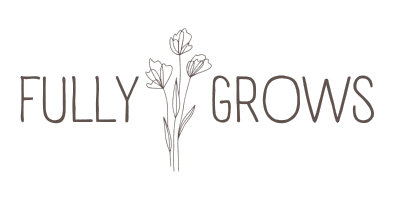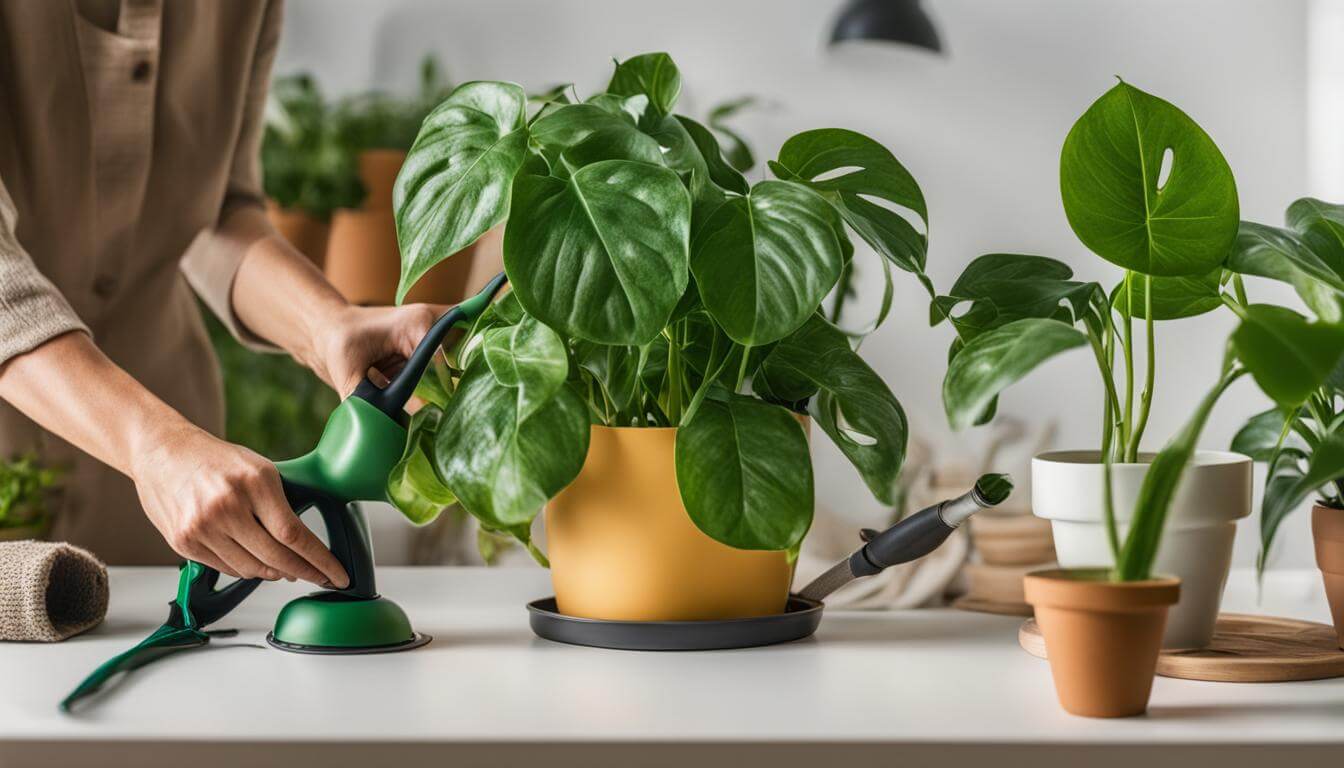The Swiss cheese plant, also known as Monstera adansonii, is a tropical perennial native to Central and South America. It is commonly grown as an indoor plant due to its large, heart-shaped leaves that develop holes as the plant ages. In this comprehensive care guide, I will share tips and tricks to help you grow vibrant and healthy monsteras in your home.
Key Takeaways:
- Swiss cheese plants, also known as Monstera adansonii, have large, heart-shaped leaves with distinctive holes.
- They thrive in bright, indirect light and high humidity levels.
- Swiss cheese plants should be watered when the top inch of soil is dry.
- Regular maintenance, including cleaning the leaves and pruning, is important for their health.
- Propagation can be done through stem cuttings or air layering.
Understanding the Swiss Cheese Plant
The Swiss cheese plant, scientifically known as Monstera adansonii, is a climbing vine with heart-shaped leaves that develop distinct holes, resembling Swiss cheese. It is a fast-growing plant, both in its natural habitat and when grown indoors. Swiss cheese plants can reach a height of up to 10-13 feet outdoors and 3-8 feet indoors, with a width of 1-3 feet. They belong to the Araceae family and are classified as perennials. Swiss cheese plants are native to Central America and South America and are toxic to pets if ingested.
The unique characteristic of Swiss cheese plants is their foliage. The leaves start out as small, solid heart shapes and gradually develop the iconic holes as the plant matures. These holes, scientifically known as fenestrations, serve a purpose for the plant in its natural habitat. They allow wind to pass through the leaves, reducing the risk of damage from strong tropical storms or hurricanes. Additionally, the holes help the plant to capture sunlight efficiently without casting too much shade on neighboring plants.
Swiss cheese plants are sought after by plant enthusiasts and collectors for their aesthetic appeal. Their lush green leaves with intricate patterns can add a touch of tropical beauty to any indoor space. These plants are relatively low maintenance and can thrive in a variety of conditions, making them a popular choice for both beginner and experienced gardeners.
Characteristics of the Swiss Cheese Plant
Here are some key characteristics of the Swiss cheese plant:
- Heart-shaped leaves with fenestrations (holes)
- Vining growth habit
- Rapid growth rate
- Height: 10-13 feet outdoors, 3-8 feet indoors
- Width: 1-3 feet
- Belongs to the Araceae family
- Perennial plant
- Native to Central America and South America
- Toxic to pets if ingested
With its unique appearance and ease of care, the Swiss cheese plant is a delightful addition to any plant lover’s collection. Understanding its characteristics and growth habits is key to successfully cultivating and caring for these beautiful plants.
Optimal Growing Conditions for Swiss Cheese Plants
Swiss cheese plants, also known as Monstera adansonii, thrive when provided with the right growing conditions. Here are some key factors to consider when caring for these beautiful indoor plants:
Light:
Swiss cheese plants prefer bright, indirect light. They are native to the shaded understory of tropical forests, so avoid placing them in direct sunlight for extended periods as it can damage their leaves. Instead, find a spot in your home that receives bright, indirect light or use sheer curtains to filter direct sunlight.
Soil and Water:
These plants do best in a well-draining potting mix that retains moisture without becoming waterlogged. A peat-based mix with added perlite or sand works well. When watering, allow the top inch of soil to dry out before watering thoroughly. Overwatering can lead to root rot, while underwatering can result in dry, wilted leaves.
Humidity and Temperature:
Swiss cheese plants thrive in high humidity environments, which replicates their natural jungle habitat. Aim for a humidity level of around 50%. You can increase humidity by misting the leaves regularly or placing a tray filled with water near the plant. These plants prefer temperatures between 60-85°F (15-29°C), so keep them away from drafts or extreme temperature fluctuations.
Fertilizer:
To promote healthy growth, fertilize your Swiss cheese plant once a month during the growing season (spring and summer) with a balanced liquid fertilizer diluted to half strength. This will provide the necessary nutrients for vibrant foliage.
| Growing Conditions | Swiss Cheese Plants |
|---|---|
| Light | Bright, indirect light |
| Soil and Water | Well-draining potting mix, water when top inch of soil is dry |
| Humidity | High humidity (around 50%) |
| Temperature | 60-85°F (15-29°C) |
| Fertilizer | Monthly application of balanced liquid fertilizer, diluted by half |
Proper Care and Maintenance of Swiss Cheese Plants
Keeping your Swiss cheese plant healthy requires regular care and maintenance. By following these guidelines, you can ensure your plant thrives and remains vibrant:
- Keep the leaves clean: Gently wipe the leaves with a damp cloth to remove dust and debris. This helps maintain healthy foliage and allows the plant to breathe properly.
- Pruning for size and health: Regular pruning is essential to control the size of your Swiss cheese plant and remove any dead or damaged leaves. Use sterile pruning shears to cut back stems by no more than 25% above a leaf node.
- Pest control measures: Swiss cheese plants can be susceptible to common houseplant pests like mealybugs, spider mites, scale, and whitefly. Keep an eye out for any signs of infestation and treat them with a nontoxic insecticide or neem oil to prevent further damage.
It’s important to note that Swiss cheese plants can also encounter diseases such as root rot, rust, powdery mildew, and blight. To minimize these issues, ensure proper watering and drainage to prevent waterlogged soil.
Regular maintenance is key to keeping your Swiss cheese plant healthy. Keep the leaves clean and free from dust by gently wiping them with a damp cloth.
In addition to regular care and maintenance, it’s essential to provide your Swiss cheese plant with the optimal growing conditions mentioned earlier in this guide. By creating a suitable environment for your plant, you can help it thrive and maintain its overall health and vitality.
| Plant Maintenance Tips | Benefit |
|---|---|
| Keep leaves clean | Prevents dust buildup and allows proper photosynthesis |
| Prune regularly | Controls plant size and removes dead or damaged leaves |
| Implement pest control measures | Prevents infestations and protects plant health |
By incorporating these care and maintenance practices into your routine, you can enjoy a thriving Swiss cheese plant that adds beauty and greenery to your indoor space.
Propagation Techniques for Swiss Cheese Plants
If you want to expand your Swiss cheese plant collection or share the beauty of these plants with others, propagation is an excellent option. There are two main techniques you can use: stem cuttings and air layering. Each method has its advantages and can be successful with proper care and attention.
Stem Cuttings
Propagating Swiss cheese plants through stem cuttings is a popular and straightforward method. Start by selecting a healthy stem with at least one leaf node intact. Using clean pruning shears, make a diagonal cut just below a leaf node. Apply a rooting hormone to the cut end to promote root development.
Next, prepare a well-draining soilless potting mix. Moisten the mix and create a hole for the cutting. Insert the cutting into the soil, ensuring that the leaf node is buried and the stem is secure. Place the pot in a warm location with bright, indirect light, and maintain lightly moist soil. Roots should start forming within a few weeks, at which point you can transfer the cutting to a larger pot.
Air Layering
Air layering is another effective method for propagating Swiss cheese plants. This technique involves creating a new root system while the stem is still attached to the parent plant. To start, select a stem that has several nodes. Make a small cut just below a node using a clean, sharp knife.
Take a handful of moist sphagnum moss and wrap it around the cut area. Secure the moss with plastic wrap, making sure it remains moist throughout the process. Roots will begin to develop within a few weeks. Once the roots are well-established, carefully cut the stem below the new root system and plant the new plant in fresh soil.
| Propagation Method | Advantages | Disadvantages |
|---|---|---|
| Stem Cuttings | Simple and straightforward | May take longer for roots to develop |
| Air Layering | Allows for the creation of a strong root system | Requires more time and attention |
Experiment with both propagation techniques to see which one works best for you. Remember to provide the proper care and environment for the new plants, and enjoy watching them grow and thrive!
Choosing the Right Pot and Repotting Swiss Cheese Plants
When it comes to choosing the right pot for your Swiss cheese plant, there are a few things to consider. First, ensure that the pot has drainage holes to allow excess water to escape. This will help prevent waterlogged soil, which can lead to root rot. You can opt for a variety of containers, including ceramic pots, plastic pots, or even hanging baskets if you prefer to showcase your plant from above. As long as the pot has drainage holes, it can provide a suitable home for your Swiss cheese plant.
When potting a nursery plant, select a container that is slightly larger than the plant’s root ball. This will give the roots room to grow without overwhelming the plant. Place the plant in the new pot at the same level it was in its nursery container, making sure not to bury the stems too deeply. Use a well-draining peat-based potting mix to provide a supportive yet breathable environment for your plant’s roots.
Repotting your Swiss cheese plant every two years is important for its overall health and growth. Signs that your plant is ready for a new pot include roots poking out of the drainage holes or through the soil, or if the soil dries out quickly after watering. Spring is the best time to repot, as it coincides with the plant’s natural growth period. Remember to choose a slightly larger pot each time you repot to accommodate the plant’s increasing size.
| Signs Your Swiss Cheese Plant Needs Repotting | How to Repot Your Swiss Cheese Plant |
|---|---|
| Roots poking out of drainage holes or through the soil | Choose a slightly larger pot with drainage holes |
| Soil drying out quickly after watering | Use a well-draining peat-based potting mix |
| Plant becoming top-heavy | Repot in the spring, when the plant is actively growing |
Proper potting and repotting are crucial steps in caring for your Swiss cheese plant. By choosing the right pot, providing proper drainage, and repotting at the appropriate time, you can ensure that your plant has the space it needs to thrive and grow. Remember to monitor your plant’s growth and signs of needing repotting, and don’t hesitate to give it a new home when the time comes.
Troubleshooting Common Issues with Swiss Cheese Plants
Swiss cheese plants are generally easy to care for, but like any plant, they can encounter some common issues. Understanding these problems and their solutions will help you keep your Swiss cheese plant healthy and thriving.
Yellowing Leaves:
If you notice yellow leaves on your Swiss cheese plant, it could be a sign of overwatering. Check the moisture level of the soil and make sure you are allowing it to dry out slightly between waterings. Adjust your watering schedule accordingly to prevent waterlogged roots.
Underwatering and Dry Soil:
Curling or wrinkled leaves are often a sign of dry soil or underwatering. To remedy this, increase the frequency of your watering, ensuring that the top inch of soil is moist but not soaked. Consider using a moisture meter to accurately gauge the moisture level of the soil.
Leaf Burn from Direct Sunlight:
Black marks on the leaves are typically caused by leaf burn from too much direct sunlight. Swiss cheese plants prefer bright, indirect light. If your plant is exposed to intense sunlight, move it to a spot with filtered light or use sheer curtains to diffuse the sunlight.
Low Light Exposure:
If your Swiss cheese plant is not getting enough light, it may experience slow growth or dropping leaves. Ensure that your plant is placed in a location with bright, indirect sunlight. If needed, you can provide supplemental light using grow lights to boost growth.
FAQ
How tall can a Swiss cheese plant grow?
Swiss cheese plants can reach a height of up to 10-13 feet outdoors and 3-8 feet indoors.
What is the ideal light conditions for Swiss cheese plants?
Swiss cheese plants thrive in bright, indirect light. Avoid exposing them to direct sunlight for more than 2-3 hours a day.
How often should I water my Swiss cheese plant?
Water your Swiss cheese plant when the top inch of soil is dry. Aim to keep the soil consistently moist but not soaked.
How do I increase the humidity for my Swiss cheese plant?
You can increase the humidity for your Swiss cheese plant by misting the leaves or using a humidifier.
How often should I fertilize my Swiss cheese plant?
Fertilize your Swiss cheese plant monthly during the growing season (March-September) using a balanced liquid fertilizer diluted by half.
How do I clean the leaves of my Swiss cheese plant?
Gently wipe the leaves of your Swiss cheese plant with a damp cloth to keep them clean and free from dust.
How do I propagate a Swiss cheese plant?
Swiss cheese plants can be propagated through stem cuttings or air layering. For stem cuttings, apply rooting hormone to a 4-6 inch piece of stem with a leaf node and plant it in moistened soilless potting mix. For air layering, make a cut under a node, wrap sphagnum moss around the cut area, and keep it moist until roots develop.
How often should I repot my Swiss cheese plant?
Repot your Swiss cheese plant every two years using fresh potting mix in a slightly larger container. Signs that your plant needs repotting include roots poking out of drainage holes or up through the soil, or if the soil dries out quickly.
What are common issues that can affect Swiss cheese plants?
Common issues that can affect Swiss cheese plants include overwatering (yellowing leaves), underwatering (curling or wrinkled leaves), leaf burn from too much direct sunlight (black marks on leaves), and slow growth or dropping leaves from insufficient light exposure.







